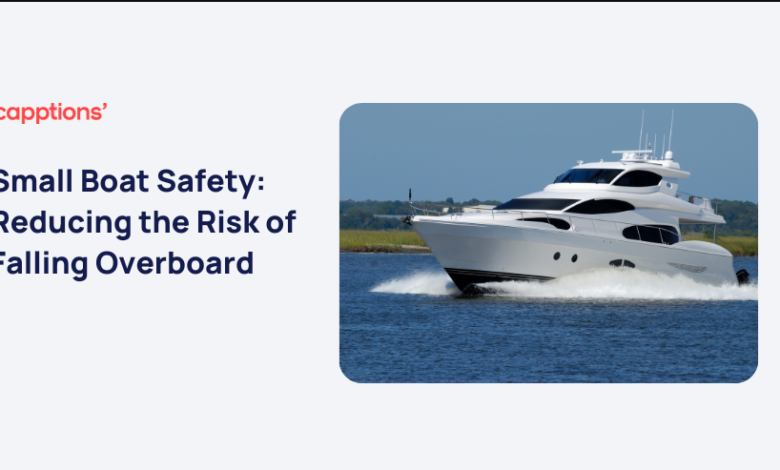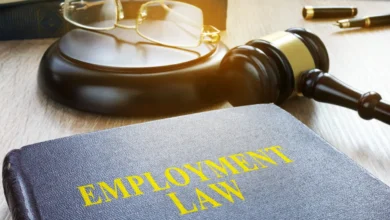Falling Overboard? Prevent Risks on Small Boats Now

To reduce the risk of falling overboard on small boats, wear a life jacket and avoid moving around unnecessarily. Keep your center of gravity low by sitting steadily.
Boating offers a thrilling adventure, especially when you’re navigating the waters in a small craft. While the excitement is undeniable, safety must always be a top priority. Small boats come with an inherent risk of individuals falling overboard due to their size and stability.
Ensuring personal safety and minimizing hazards require proactive measures. Acquiring well-fitted life jackets for all passengers and educating them about staying seated can significantly lessen the risk. Mastering the boat’s operations, understanding weather conditions, and avoiding alcohol consumption contribute to a safer boating experience. These safety precautions embody responsible boating practices, which are necessary for enjoying the water while safeguarding against accidents. By adhering to these strategies, you can help ensure that your time at sea is not just pleasurable but also secure.
Contents
The Risks Of Small Boat Excursions
Exploring the water on a small boat offers adventure and excitement. Yet, it comes with risks. One major risk is falling overboard. This threat increases on small boats due to their size and stability. Understanding the risks helps us prepare and enjoy our time on the water safely.
Causes Of Overboard Accidents
Several factors can lead to overboard incidents on small boats:
- Uneven Weight Distribution: Too much weight on one side can tip a boat.
- Sudden Movements: Quick turns or stops can throw passengers off balance.
- Slippery Surfaces: Wet decks make slips and falls more likely.
- Weather Conditions: Storms, winds, and waves can rock the boat unexpectedly.
- Lack of Safety Measures: Handrails or adequate safety gear contribute to accidents.
Dangers Of Falling Into Water
Falling overboard poses several immediate dangers:
| Danger | Impact |
| Hypothermia | Cold water can lower body temperature fast, leading to hypothermia. |
| Drowning | Strong currents or inability to swim can cause drowning. |
| Injury | Hit by the boat or debris in the water can cause serious injury. |
| Shock | Sudden immersion in cold water can lead to gasping and panic. |
| Separation from Boat | Drifting away from the boat can hinder rescue efforts. |
Essential Safety Gear For Boaters
Staying safe on the water means having the right gear. Small boats can be fun. But they can tip over easily. To lower the risk of falling overboard, use safety gear. Let’s talk about some must-have items.
Life Jackets And Personal Flotation Devices
Life jackets save lives. It’s that simple. Everyone needs one on a boat. The law says so, and common sense agrees.
- Check the fit: A life jacket should be snug but not too tight.
- Right type: There are many types. Pick one for your water activity.
- Bright colors: Pick a jacket that’s easy to see in the water.
Children need special life jackets. These have extra features to keep their heads above water.
Man Overboard Alarms And Devices
Man, overboard devices are smart. They make a loud noise when someone falls in, which helps the driver stop fast and find the person in the water.
| Type | How It Works |
| Personal Alarm | Wear it. It beeps loudly when wet. |
| Manual Alarm | Push a button to make noise if you see someone fall. |
Also, consider a GPS device. If someone goes overboard, it can send your boat’s exact location.
Always test your gear before leaving shore. It should work right every time. And remember, gear can’t replace being careful. Stay alert. Watch the water. Keep everyone on board safe.
Crew Training And Drills
Falling overboard on small boats is not a small matter. It’s a life-and-death scenario. Crew training must be used to tackle this risk. Crew members need to know what to do in case someone falls overboard. Drills and practice make these responses second nature. Now, let’s look at how regular safety drills and better communication can keep everyone safer on the water. When it comes to repairing the boat, its better for crews to use polyform fender covers to use as a safety barrier.
Conducting Regular Safety Drills
Practice makes perfect. Regular safety drills train crews to act quickly and effectively. Drills should cover:
- Man Overboard procedures
- First-aid response
- Use of life-saving equipment
- Recovery techniques
Use a dummy or buoy to simulate real-life conditions. Time each drill. Aim to improve speed and precision with each session. Record the results. Show progress over time. Crews that drill regularly stay sharp and ready.
Improving Communication And Coordination Onboard
Good communication saves lives. Teach the crew clear hand signals and the use of radios. Create a communication plan. The plan should include:
| Who | What | When | How |
| Lookout | Alerts crew | Immediately after the man went overboard | Shouting and signaling |
| Helmsman | Maneuvers boat | After alert | Follows MOB procedures |
| Rescue Team | Prepares to recover the person | After the helmsman’s maneuver | Ready with lifebuoy and recovery equipment |
Run communication drills. Make sure everyone knows their role. A boat with a well-coordinated crew is a safer boat.
Crews that train together and communicate well stand the best chance of preventing a tragedy. Remember, when it comes to safety at sea, preparation is key.
Staying safe on a small boat involves more than just wearing a life jacket. Knowing about the weather and how to navigate can save lives. To keep from falling overboard, it’s essential to understand how the weather can change and affect water conditions. Equally crucial are navigation skills to guide you safely.
Monitoring Weather Conditions
- Check forecasts before departure.
- Equip your boat with a weather radio.
- Watch for sudden changes in wind, clouds, and temperature.
- Learn to recognize signs of storms or bad weather.
- Postpone or end your trip if conditions worsen.
Continuous weather updates alert you to potential dangers, helping keep everyone aboard safe. By monitoring the weather, you prioritize the safety of your crew and passengers.
- Learn about the local currents and tides.
- Understand how to read nautical charts and use navigational tools.
- Always keep a compass and updated GPS device onboard.
- Practice steering and maneuvering in different conditions.
- Take a boating safety course to sharpen your skills.
Mastering navigation ensures you can handle your boat well. It also keeps you prepared for unexpected currents or shifts in the water. These skills are your best defense against accidents, such as falling overboard.
Always prepare, stay keen, and respect the power of nature. Boost your safety on water by honing weather awareness and navigation skills. This will ensure fun and memorable boating experiences with a reduced risk of accidents.
Small Boat Stability And Load Management
Boating on a small boat brings with it the risk of falling overboard. Ensuring the boat’s stability and managing its load helps reduce this risk. Let’s look at ways to maintain stability and manage load effectively.
Distributing Weight Evenly
Keeping the boat balanced is key. Weight distribution affects how a boat handles waves and turns. Follow these steps:
- Place heavy items in the center of the boat.
- Avoid piling gear on one side.
- Distribute passengers to balance the boat.
When items and people stay even, the boat remains stable. Check this balance throughout your trip.
Dealing With Sudden Shifts
Sudden movements can make a boat trip. Here’s what to do:
- Instruct passengers on moving safely.
- Secure loose gear to prevent unexpected shifts.
- Practice slow, controlled turns to prevent tipping.
Preparing for unexpected changes helps keep everyone aboard safe.
Preventing Slips And Falls On Deck
Preventing slips and falls on deck is crucial for ensuring safety aboard small boats. Incidents of falling overboard often stem from losing one’s footing. By implementing targeted measures to keep the deck as slip-free as possible, boat owners can significantly reduce risk.
Non-slip Deck Solutions
Non-slip solutions are essential for a safe deck surface. Surfaces can become slick from water, algae, or fish scales. Many products exist to create a non-slippery deck:
- Anti-slip paints with fine granules provide grip underfoot.
- Self-adhesive grip tapes are easy to apply and very effective.
- Rubber matting can cover large areas and offer excellent traction.
Clearing Obstacles And Safe Movement Practices
Keeping the deck clear of gear, lines, and tackle is the first step in avoiding accidents. Safe movement on board also involves:
- Ensuring everyone understands the importance of neatness.
- Stowing gear immediately after use to avoid tripping hazards.
- Walking cautiously, especially in rough conditions.
Alcohol And Boating Don’t Mix
Falling overboard from a small boat is a danger. Adding alcohol into the mix only increases this risk. Sea lovers must understand that the festive atmosphere of boating can turn difficult with alcohol. This section delves into why keeping clear of alcohol is crucial for safety on the water.
The Impact Of Intoxication On Balance
Intoxication affects balance, which is crucial for staying aboard. On a swaying boat, this becomes even more important.
- Alcohol impairs your inner ear, disrupting your equilibrium.
- Your reaction time slows, making it difficult to adjust and maintain footing.
- The risk of tripping or slipping on wet surfaces increases with every drink.
Legalities And Liability
Boat operators must know the legalities of drinking and boating. The law often treats this as seriously as driving under the influence.
| Aspect | Details |
| Boating DUI | Similar consequences to land DUI |
| Laws | It varies by region, but penalties can be severe |
| Liability | If an accident occurs, you’re responsible |
Boat operators must understand their responsibility. This means staying sober to keep all passengers safe. Skip the alcohol, stay alert, and maintain a safe environment for everyone on board.
Emergency Response Plans
Going overboard on a small boat is a scary situation. But, being ready with an emergency response plan can save lives. This plan sets clear steps for what to do. Everyone on the boat must know the plan well. It’s like having a life-saving map in your head.
Quick Actions To Retrieve Overboard Individuals
Time is critical after someone falls into the water. The plan should list immediate actions. This includes shouting, “Man Overboard,” stopping the boat, and keeping eyes on the person. Use life rings or flotation devices to help them. A quick-throw rope is useful, too.
- Shout “Man Overboard” to alert everyone.
- Stop the boat quickly.
- Keep the person in sight at all times.
- Throw life rings or flotation aids to them.
Coordination With Search And Rescue
If the person can’t get back on the boat, call search and rescue immediately. Use the radio to send a mayday signal. Give details about your location and the person overboard. Clear communication helps search and rescue and finds you fast.
| Step | Action |
| 1 | Call for help using VHF radio or phone. |
| 2 | Send a mayday with location details. |
| 3 | Follow instructions from authorities. |
Conclusion
Ensuring safety on small boats is vital. Adopt proactive measures like wearing life jackets and staying seated. Practice communication and safety drills regularly. By prioritizing these precautions, you significantly diminish the risks of falling overboard. Stay safe and enjoy the water with confidence.


